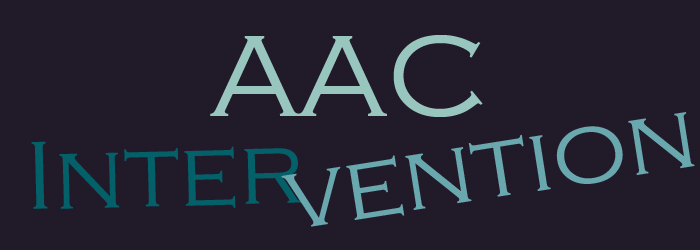

Guided Reading: Reading / Writing / Speaking Listening series
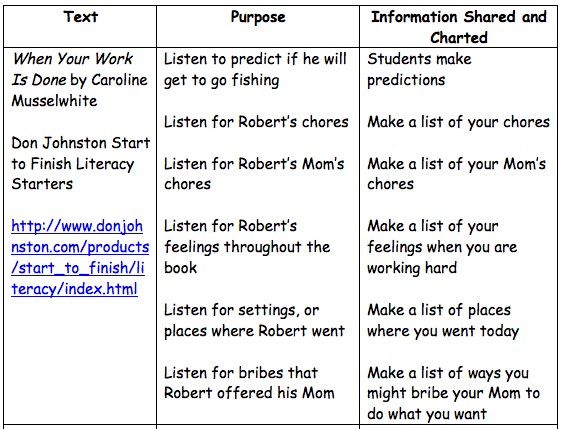
This tip provides suggestions for integrating reading, writing, speaking, and listening during guided reading instruction. Sample texts, guided reading goals, and strategies are provided.

return to top

Poetry: Reading/Writing/Speaking/Listening Series
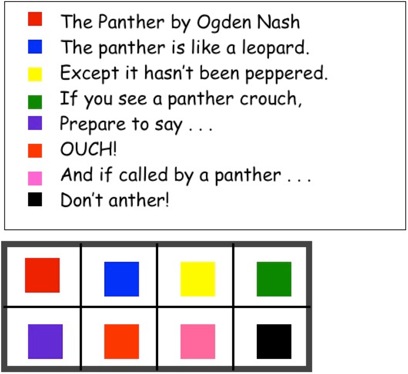 In her delightful book, Teach Me a Poem, Lorraine Wilson (1994) suggests that students must engage in four activities to become poetry writers: immersion, demonstration, writing, and response. This tip shows how those phases can be used to integrate reading, writing, speaking, and listening. Suggestions are made for adapting activities for students with a range of disabilities. In her delightful book, Teach Me a Poem, Lorraine Wilson (1994) suggests that students must engage in four activities to become poetry writers: immersion, demonstration, writing, and response. This tip shows how those phases can be used to integrate reading, writing, speaking, and listening. Suggestions are made for adapting activities for students with a range of disabilities.
February 2011
return to top

Writer's Bingo: Read/ Write / Speak Listening Series
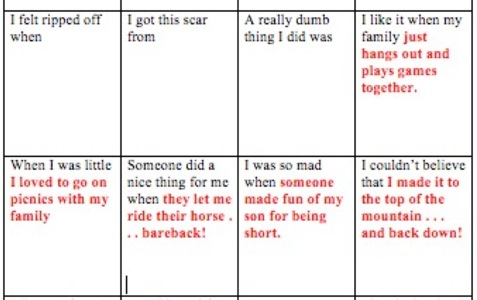 Rog & Kropp (The Write Genre, 2004) suggest using the Writing Bingo strategy to support students in developing topics for future writing. This strategy supports students in thinking about topics they might not have considered. Rog & Kropp (The Write Genre, 2004) suggest using the Writing Bingo strategy to support students in developing topics for future writing. This strategy supports students in thinking about topics they might not have considered.
This tip provides the how-to for fully using Writing Bingo, in order to integrate reading, writing, speaking, and listening. Suggestions are provided for students who use AAC.
return to top

Using AlphaBoards to Support Emergent Literacy
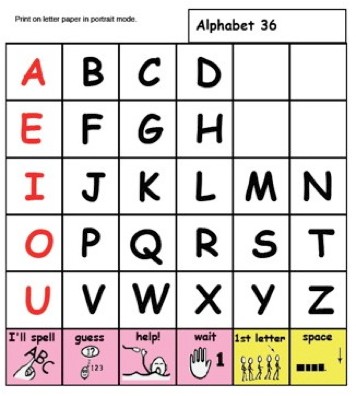 The AlphaBoard is a light tech alphabet display with CAPS on one side and lower case on the other. It is used for students who can direct select, to help them figure out how to spell words that they want to write. This is ONLY a scaffold for very beginning writers, and should be used for a short time, to support students in figuring out what letters to write. We have had enormous success with this scaffold, but it is crucial to know when to fade it! The AlphaBoard is a light tech alphabet display with CAPS on one side and lower case on the other. It is used for students who can direct select, to help them figure out how to spell words that they want to write. This is ONLY a scaffold for very beginning writers, and should be used for a short time, to support students in figuring out what letters to write. We have had enormous success with this scaffold, but it is crucial to know when to fade it!
return to top
Using Light Tech Sets to Support Literacy
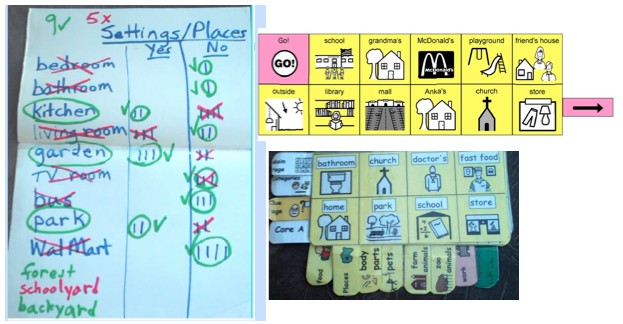
This tip is a companion tip to the August, 2010 Tip, Light Tech Symbol Sets.
Learn strategies for using light tech symbol sets to support:
• Shared Reading
• Guided Reading
• Writing: Topic Setting
• Writing: Word Choice
The graphic shows two sample light tech sets that might be used to predict locations for bugs . . . or to set topics for writing.
return to top

Developing an Ear Print for Synthetic Speech
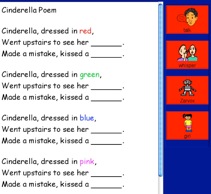 Not all students find text-to-speech natural and easy to understand, even though the voices are improving all the time. This strategy is designed to help students who use voice output for communication or who need voice output to help support reading to listen to a variety of text forms using synthetic text-to-speech tools. This tip describes some of the tools and gives ideas to support repetition with variation (different text forms, different voices, different medium). Not all students find text-to-speech natural and easy to understand, even though the voices are improving all the time. This strategy is designed to help students who use voice output for communication or who need voice output to help support reading to listen to a variety of text forms using synthetic text-to-speech tools. This tip describes some of the tools and gives ideas to support repetition with variation (different text forms, different voices, different medium).
June 2011
return to top
Using AAC Devices to Create Text Files
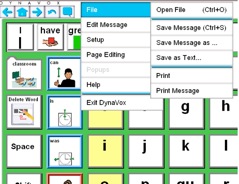 This strategy is designed to help students using AAC devices from Dynavox or Prentke Romich Company to use their devices to type text into another computer. Options in this tutorial include use of wireless receivers and USB cables. Once connected, the AAC device becomes an alternative keyboard. Type letters from the keyboard/letter pages or pre-programmed text from symbol buttons. Use with a computer connected to a projector for a group lesson! This strategy is designed to help students using AAC devices from Dynavox or Prentke Romich Company to use their devices to type text into another computer. Options in this tutorial include use of wireless receivers and USB cables. Once connected, the AAC device becomes an alternative keyboard. Type letters from the keyboard/letter pages or pre-programmed text from symbol buttons. Use with a computer connected to a projector for a group lesson!
return to top

Predicting Using Names
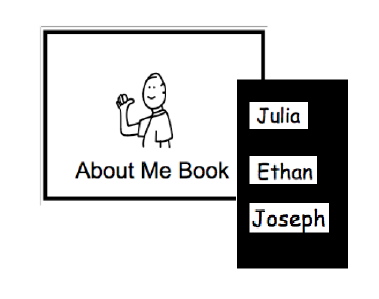 This strategy is designed to help students make predictions using the names of students in their class. It also helps teachers think about reading comprehension lessons that focus on reading for just one purpose. In this example, the purpose is predicting the best title of the book. This activity is a follow-up to writing an “About Me” book for each student. This strategy is designed to help students make predictions using the names of students in their class. It also helps teachers think about reading comprehension lessons that focus on reading for just one purpose. In this example, the purpose is predicting the best title of the book. This activity is a follow-up to writing an “About Me” book for each student.
August 2011
return to top

Using AAC Devices as Pencils
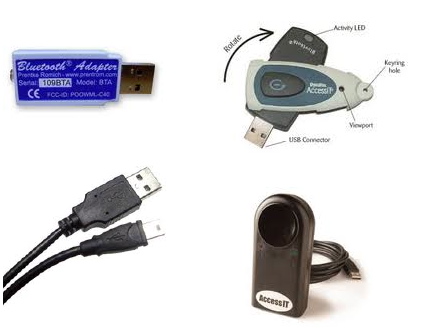 This strategy is designed to help students using AAC devices from Dynavox or Prentke Romich Company to use their devices to type text into another computer. Options in this tutorial include use of wireless receivers and USB cables. Once connected, the AAC device becomes an alternative keyboard. Type letters from the keyboard/letter pages or pre-programmed text from symbol buttons. Use with a computer connected to a projector for a group lesson! This strategy is designed to help students using AAC devices from Dynavox or Prentke Romich Company to use their devices to type text into another computer. Options in this tutorial include use of wireless receivers and USB cables. Once connected, the AAC device becomes an alternative keyboard. Type letters from the keyboard/letter pages or pre-programmed text from symbol buttons. Use with a computer connected to a projector for a group lesson!
return to top

Using Zamzar to Convert YouTube Videos
 This tip will show you how to convert a YouTube Video. YouTube videos are stored in an *.flv format, which cannot be played directly on your computer by Windows Media Player or QuickTime. This tip will show you how to convert a YouTube Video. YouTube videos are stored in an *.flv format, which cannot be played directly on your computer by Windows Media Player or QuickTime.
Here are some reasons why you would want to use videos in therapy or teaching:
- Visual supports in classrooms
- Building vocabulary (e.g. Illustrating new words)
- Music – teaching vocabulary through songs
- Sequencing – (e.g. how to make a fried egg, popcorn, etc.)
- Completing a task independently
- Expand on a basic theme (studying apples, then using a video about an apple
orchard)
- Motivating and unusual videos for writing prompts, (e.g. watching popcorn popping at a normal speed, and then slowed down).
The sky is the limit.... be creative!
return to top

Favorite Book Lists (Circa 1999)
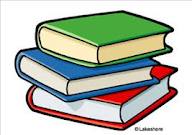 Sometimes lists just don't go out of date. The November 2011 tip revisits a link of repeated line books, and other favorite book lists that was originally posted in 1999. This list is being offered again due to a special request from a long time AACIntervention user, Alycia Berg, an SLP from the East Coast. A favorite link of hers had disappeared when we re-vamped the website. Given that the books are still in print, and everyone needs good books in their classroom, we are offering the lists as a "Tip of the Month". To all you other longtime users of AACIntervention, please let us know if some favorite something has vanished. We will do our best to put it back. Sometimes lists just don't go out of date. The November 2011 tip revisits a link of repeated line books, and other favorite book lists that was originally posted in 1999. This list is being offered again due to a special request from a long time AACIntervention user, Alycia Berg, an SLP from the East Coast. A favorite link of hers had disappeared when we re-vamped the website. Given that the books are still in print, and everyone needs good books in their classroom, we are offering the lists as a "Tip of the Month". To all you other longtime users of AACIntervention, please let us know if some favorite something has vanished. We will do our best to put it back.
And, Alycia... Thanks!
return to top

Modeled Writing
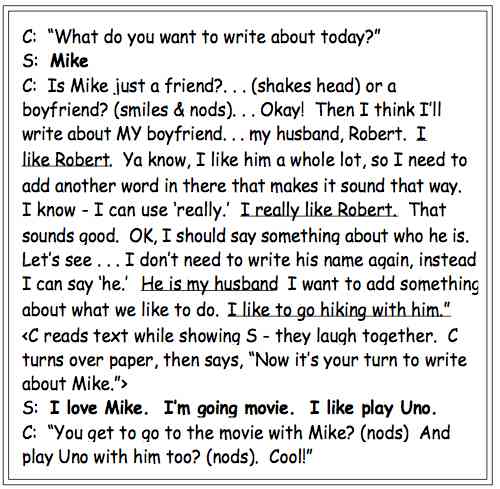 Modeled writing is a strategy in which a competent writer shows how they figure out what or how to write, using ‘talk aloud’. Modeled writing is especially useful for students who are very beginning writers. The strategy also supports students who use alternative pencils, such as communication devices, eye gaze alphabets, or alphabet flipboards. This tip provides step-by-step directions, so that partners can be effective models of writing. Modeled writing is a strategy in which a competent writer shows how they figure out what or how to write, using ‘talk aloud’. Modeled writing is especially useful for students who are very beginning writers. The strategy also supports students who use alternative pencils, such as communication devices, eye gaze alphabets, or alphabet flipboards. This tip provides step-by-step directions, so that partners can be effective models of writing.
December 2011
return to top
 Our little idea guy marks the tip attachments. They are posted in pdf format. On the few occasions where there was more than one document to attach, we have "zipped" the files. Our little idea guy marks the tip attachments. They are posted in pdf format. On the few occasions where there was more than one document to attach, we have "zipped" the files.
PDF File Information
If you don't have Acrobat Reader on your computer, go to the following site:
http://get.adobe.com/reader/
Contact us if you need tips in another format.
|
